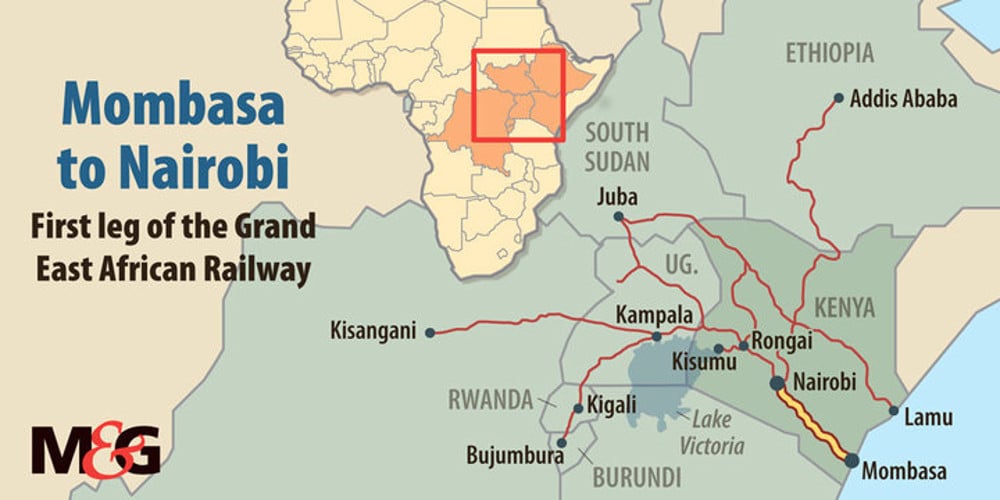President Uhuru Kenyatta flies the flag as a cargo train leaves the Mombasa container terminal for its inaugural journey to Nairobi. The new line is expected to invigorate Kenya’s economy by making trade easier and cheaper.
In 1895, in a fit of colonial hubris, construction began on a railway line that would link the port of Mombasa with the rest of British East Africa. Infamously, critics in London dismissed the project as “naught but a lunatic line”, and they weren’t far wrong.
Its completion, six years later, was an engineering and logistical miracle. At vast expense and at great human cost, the tracks were forced through uncharted desert and over the sheerest precipices. Workers had to contend with dire working conditions, disease, occasional bouts of conflict with locals and even a pair of man-eating lions.
The line was finished in 1901, and ever since then the “Lunatic Express” has been a vital — if never especially reliable — artery for East African trade. But in recent years, that artery has become increasingly clogged, which is why Kenya decided it needed to build a new one.
It was significantly easier this time around. China stumped up more than 80% of the $3.2‑billion total cost, and Chinese firms took just three years to complete construction. Their influence is evident on board the trains that operate on the new line, with cabin attendants who can communicate in English, Swahili and Mandarin.
The new railway is built on standard gauge tracks, which are wider than the old ones, meaning that the new trains can travel faster and carry much heavier loads.
On Wednesday, the new Lunatic Express set out on its maiden voyage from Mombasa to Nairobi, the capital city (which, incidentally, began life as a depot during the construction of the old line).
It traversed 475km of shiny new track and carried a full complement of 1 200 passengers. When it’s running on a normal schedule, the journey time between the two cities will more than halve, taking less than five hours. The trip will cost 700 Kenyan shillings (R89) in economy class.
In another milestone, the train was driven by two Kenyan women — the country’s first female train drivers.
Among the passengers was Kenyan President Uhuru Kenyatta, who was visibly excited as he boarded. “Today we celebrate one of the key cornerstones to Kenya’s transformation to an industrialised, prosperous, middle-income country,” he said.

The new railway, coupled with the ongoing expansion of Mombasa’s port, is central to Kenya’s economic growth plans. It is designed to make international trade cheaper and more efficient. And it’s not just Kenya that should benefit: the Mombasa-Nairobi leg is just the first step in the grand East African Railway Master Plan, which will eventually link Kenya with Uganda, Rwanda, Burundi, Ethiopia and South Sudan.
Not everyone is on board. Some critics point to China’s involvement as evidence of a dangerous new colonial influence, and say that Kenya could have negotiated for a better deal. Others observe that the timing of the inaugural journey is very convenient for Kenyatta, who has just officially begun his re-election campaign ahead of the presidential vote in August.
But these quibbles miss the point, suggested influential Kenyan columnist Linus Gitahi. He argues that the potential benefits far outweigh any other concerns. “A single transformative event can shape the destiny of a nation. It can upend convention and leapfrog several developmental stages. The commissioning of the standard gauge railway between Nairobi and Mombasa is one such event … it is full steam ahead, as we race to catch up with countries that realised a long time ago the central role that a railway plays in the development cycle,” Gitahi wrote in the Daily Nation.
Kenya is not the only country catching up. In January, Ethiopia finished building its own new railway. This links the capital, Addis Ababa, to the port in neighbouring Djibouti, which is also being expanded. When fully opened, the line will slash the journey time from three days by truck to just 10 hours.
“I hope it will not be too long before we are able to travel by rail from Djibouti to Dakar and other West African cities,” said Ethiopia’s prime minister, Hailemariam Desalegn.
His dream of a Djibouti-to-Dakar route is a perpendicular echo of Cecil John Rhodes’s famous, unrealised vision of a single, uninterrupted Cape-to-Cairo track.
For now it is just as unrealistic. Although Kenya and Ethiopia are pouring money into rail infrastructure, with other East African countries set to follow, Africa’s other regional communities have no solid plans to start laying down sleepers. Maybe they are the real lunatics.